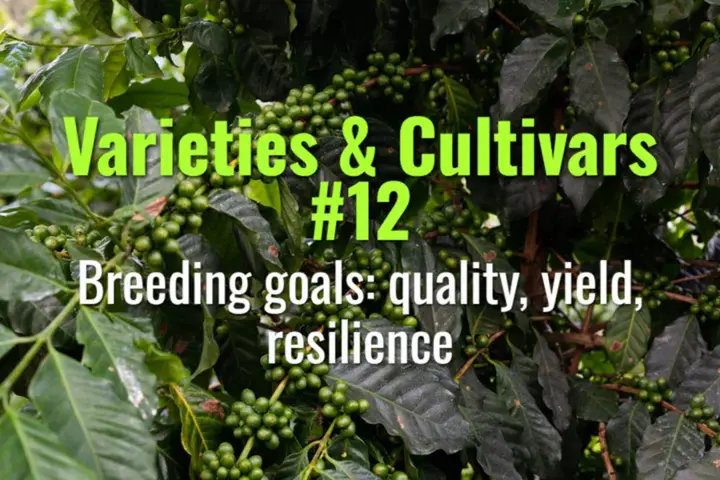Breeding goals: quality, yield, resilience
This topic explains the main goals of modern coffee breeding—improving cup quality, increasing yield, and enhancing resilience—and how these often competing priorities shape the future of coffee.
- Coffee Basics Nerds
- 2 min read
Article 12 of 12 in Varieties & Cultivars/

Background
Coffee breeding is a strategic response to global challenges: rising demand, climate change, disease pressure, and consumer expectations for flavor. Breeding programs aim to combine the strengths of heritage Arabicas with the resilience of hybrids.
Goal 1: Cup Quality
- Focus: Flavor complexity, aroma, balance, and acidity.
- Heritage varieties: Typica, Bourbon, Gesha prized for their exceptional flavor but limited in resilience.
- Approach: Breeders cross quality-focused Arabicas with resilient varieties to maintain specialty cup traits.
- Measurement: Cupping scores (80+ for specialty); sensory analysis guides selection.
Goal 2: Yield
- Focus: High productivity to ensure farmer profitability and global supply.
- Challenges: Heritage varieties like Typica and Bourbon are low-yielding.
- Breeding outcomes: Varieties like Caturra, Catuaí, and Castillo combine higher yields with manageable plant size.
- Trade-off: High-yield plants often mature cherries faster, which can reduce density and flavor complexity.
Goal 3: Resilience
- Focus: Resistance to diseases (coffee leaf rust, coffee berry disease) and tolerance to drought, heat, or frost.
- Robusta genes: Used in hybrids (e.g., Timor Hybrid) to introduce rust resistance.
- Modern hybrids: Ruiru 11, Batian, and F1 hybrids balance resilience with acceptable quality.
- Climate adaptation: Breeding for resilience is increasingly urgent as warming reduces Arabica’s viable zones.
Balancing the Goals
- The triangle of breeding: Quality ↔ Yield ↔ Resilience.
- Improving one trait often risks weakening another.
- Example: Castillo (Colombia) prioritized resilience and yield, with mixed reviews on cup quality.
- Example: Gesha maximizes quality but sacrifices yield and resilience.
Methods Used
- Crossbreeding Arabica × Arabica (quality + productivity).
- Introgression of Robusta traits (disease resistance).
- Marker-assisted selection and genomic sequencing to speed up breeding.
- Field trials and cupping ensure traits align with farmer and market needs.
Lasting Importance
Breeding goals determine the future of coffee farming and consumption:
- Quality keeps specialty markets alive.
- Yield secures farmer livelihoods and supply.
- Resilience ensures survival under climate change and disease threats.
The art of breeding is finding the balance—safeguarding coffee as both a global commodity and a cultural treasure.